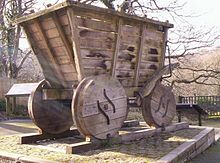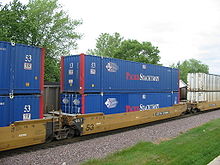- Gondola (rail)
-
This article is about US railroad practice. For information on European open wagons, see Open wagon.
 A railroad gondola seen at Rochelle, Illinois.
A railroad gondola seen at Rochelle, Illinois.
In railroad terminology, a gondola is an open-top type of rolling stock that is used for carrying loose bulk materials. Because of its low side walls, gondolas are used to carry either very dense material, such as steel plates or coils, or bulky items such as prefabricated pieces of rail track.
Contents
History
Before the opening of the Baltimore & Ohio Railroad and the Chesapeake & Ohio Canal in Harpers Ferry, Virginia (now West Virginia), considerable amounts of coal were carried via the Potomac River. Since timber was an abundant resource, flat boats, called "gondolas" (a spoof on Venetian rowing boats), were constructed to navigate the "black diamonds" down river to markets around Washington, DC. There, both the boat and cargo were sold and the boatmen returned home by foot. The railroad cars first employed in the haulage of coal were thus named after these shallow-draft boats called "gondola cars".
Early gondola cars typically had low sides. Their contents had to be shoveled out by hand, and they took a long time to unload. In 1905, the Ralston Steel Car Company patented a flat bottom gondola with lever operated chutes that allowed the gondola to be unloaded automatically from the bottom. The chutes would direct the contents of the gondola to the sides. This coincided with the switch from wood to steel freight cars, as the pulling force of locomotives tended to crush the older wood cars.
Specialized car types
Chaldrons
The first railway bulk-cargo gondolas, indeed the first freight wagons, were the chaldron cars of the early coal-carrying plateways. These were relatively short and tall in proportion, with a tapered body that widened upwards, above the wheels. Once locomotive haulage began, the unstable and top-heavy nature of this design became a problem with increasing speeds and later wagons became lower and longer. The chaldron shape survived in a few cases, such as low-speed working around a large factory site, such as a steelworks.
"Bathtub" gondolas
 A bathtub gondola passing through Rochelle, Illinois, May 29, 2005.
A bathtub gondola passing through Rochelle, Illinois, May 29, 2005.
In the second half of the 20th century, coal haulage shifted from open hopper cars to high-sided gondolas. Using a gondola, the railroads are able to haul a larger amount of coal per car since gondolas do not include the equipment needed for unloading. However, since these cars do not have hatches for unloading the products shipped in them, railroads must use rotary car dumpers (mechanisms that hold a car against a short section of track as the car and track are slowly rotated upside down to empty the car) or other means to empty them. The term "bathtub" refers to the shape of the car.
Coil car
Main article: Coil carCoil cars (also referred to as "steel coil cars" or "coil steel cars") are a specialized type of rolling stock designed for the transport of coils (i.e., rolls) of sheet metal, particularly steel. They are considered a subtype of the gondola car, though they bear little resemblance to a typical gondola.
Container well cars
Main article: Well carSpecialized cars designed to carry intermodal containers (shipping containers) resemble traditional gondolas, although their floors are usually partially open. A depressed center section provides a floor which is only inches above the rails. This stabilizes the container by lowering the center of gravity, it also allows double-stacking on those lines where the structure gauge is sufficiently high. It is always impossible to double-stack on regular flatcars because there exists no structure gauge which would allow that. It is also used to transport shipping containers single-stacked on those lines with an insufficiently high structure gauge. Single-unit well cars exist, but 3- and 5-car articulated sets are common. These reduce weight by reducing the number of trucks by nearly half, and also reduce the amount of slack in the train since there are fewer couplers. This protects the cargo by reducing the jolts that occur at starting and stopping caused by slack.
Lorry or Mine car
 A mine car, drawing from the United States Bureau of Mines.
A mine car, drawing from the United States Bureau of Mines.
An open railroad car (gondola) with a tipping trough, often found in mines. Known in the UK as a tippler or chaldron wagon.[1] Known in the USA as a mine car.[2]
Modalohr road trailer carriers
Main article: ModalohrModalohrs are specialized railroad cars for carrying road trailers and road tractors on a route from France to Italy and Luxembourg to Spain and vice versa. A deck between the bogies (trucks) pivots (swings) 30°, allowing the trailers to be loaded from the sides. For details see the official sites [3] or.[4] The cars are built by Lohr Industrie.
Track ballast gondolas
Track ballast gondolas carry ballast.
Sources
- Double Stack Intermodal Cars-Freight [5]
- Origins of name in railroad use [6]
Naming
- In Australia these wagons are called open wagons.
See also
References
External links
- Atchison, Topeka and Santa Fe Railway #72312 — photos and short history of an example of a typical steel, four-axle, solid bottom, fixed end, mill gondola.
- Guide to Railcars
Rail transport freight equipment Enclosed equipment Autorack · Boxcar (US) · Coil car · Container · Covered hopper · Covered wagon · Refrigerator car (US) · Refrigerated van (EU) · Roadrailer · Stock car · Tank carOpen equipment Flatcar · Gondola (US) · Hopper car · Open wagon (EU) · Modalohr · Schnabel car · Double-stack car · Mineral wagon · Slate wagonNon-revenue equipment Caboose (US) · Brake van (EU) · Work trains · Scale test car · Clearance car · Crane (railroad) · Rotary snowplowCategories:- Freight equipment
- Rail transport terminology
Wikimedia Foundation. 2010.



